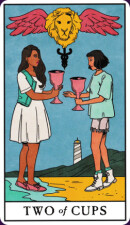The Modern Witch Tarot has 78 youthful, contemporary cards with illustrations of all kinds of women, femmes, and the gender fluid.
Browse All Decks from A - Z
Created by a French artist, the Tarot de la Rea resembles the Tarot de Marseilles with its wood-block images and plentiful use of blue and red. It was issued in two versions, "gold" and regular. Both use gold and silver ink on the cards, but the "gold" version has gilt edges.
The Tarot de la Revolution is coloured in red, white and blue and has basic artwork iillustrating the theme of the French revolution. The majors and courts are roughly matched with historical figures and scenes, while the minors have similarities to playing cards.
El Tarot de las Brujas is a Spanish deck (the title translates as the Tarot of the Witches). It has 28 cards, 21 of which correspond to the major arcana, and the other 7 show tools common to Witchcraft and are interspersed through the other majors.
The Tarot de Marcelino is a Marseilles-inspired deck in a very quirky and distinct style, from the 'Not-So-Master of Cutesy Cards' (otherwise known as Lynyrd Narciso). It's a full 78-card deck, but does have pips rather than illustrated minor arcana. It's printed in burgundy ink on unbleached paper, and has been published in a limited edition of 70 decks.
Tarot de Marseille (Camoin-Jodorowsky) ![]()
Camoin and Jodorowski, French Tarot scholars, have restored crisp detail and outlines in their variation of the Tarot of Marseilles woodcut images.
Tarot de Marseille (Dussere Dodal) ![]()
The Tarot de Marseille published by Dussere reproduces the images of the original 78-card deck by Jean Dodal, dating from 1701 in Lyon, France. Unfortunately the deck is now out of print and difficult to obtain.
The Fournier-published Tarot de Marseille sticks fairly closely to the traditional symbolism but uses much more blended, rich, flowing colour than the early woodcuts. The background colours are also a modern addition.
This Tarot de Marseille, from French publishers Héron, is a modern duplication of Conver's 1760 Marseilles images which now reside in the Bibliothèque Nationale in Paris.
This Tarot de Marseille, published by Piatnik, is very traditional in its wood-cut reproductions coloured with slightly muted blues and reds on a cream background.
The Tarot de Marseille Convos is a modern rendition of the French Marseilles Tarot. This Swiss edition has brighter coloured, rounder illustrations.













